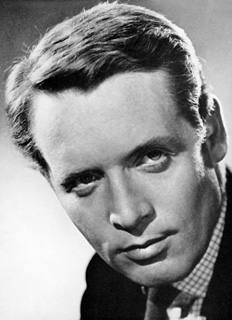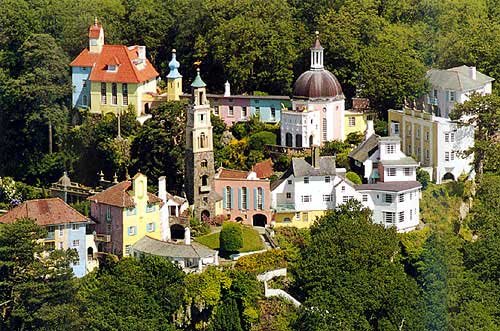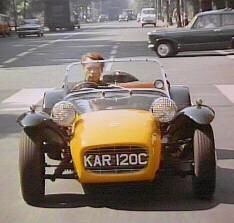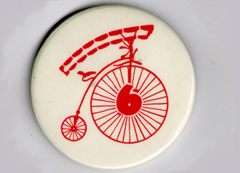  |
  |

Many people have asked why I like The Prisoner, and I answer, "I don't know!"The Prisoner was first mooted in the early 1960's, when Patrick McGoohan was filming Danger Man.

Patrick McGoohan, before Danger Man!
One episode was supposed to be in an exotic part of the world, but was actually filmed on location in Portmeirion in North Wales.Portmeirion is an Italienate village, built by Sir Clough Williams-Ellis, who, starting in 1925, bought Mediterranean buildings, dismantled them, shipped them to Wales, and re-assembled them!
Sadly, Sir Clough died in 1975.
The entire village is a currently used as a hotel, and many guests are year-long residents.
When Pat and scriptwriter George Markstein were actually filming scenes in Portmeirion, one suggested to the other that this village was ever-so-slightly menacing, and wouldn't it make an exquisite gilded cage?
So the seed of an idea was born, but just stayed out of sight.
Some years later, it was decided that Danger Man had exhausted all permutations of storyline, except one.

Portmeirion, Wales.
The gilded cage idea came back to haunt George and Pat, so they teamed up with producer David Tomblin to explore more ideas.One idea that surfaced was that of Danger Man resigning. How would his masters react? Would they think he was dangerous to them? How much damage could he inflict if he were to defect?
No. 'The Establishment' could take no chances. Paul Drake (Danger Man) would have to be placed somewhere where he could not pose any kind of risk to his former bosses.
So, in the opening scenes of The Prisoner, we see one angry man in a Lotus Seven tearing down the road to the office that he formerly worked in.

Patrick McGoohan, before The Prisoner, and after Danger Man!
As the titles proceed, Drake walks along a dimly-lit corridor and flings open the double doors at the end, and storms in. The man sitting at the desk is Potter, a one-time superior officer to Drake, whom in his anger, slaps an envelope containing his letter of resignation down on the desk, following it with a thump that breaks Potters tea plate.Drake then exits, and makes his way home, but fails to notice that he is being followed by a hearse.
He goes into his house, and starts packing. Clothes, passport, and foreign currency go into a valise.
An undertaker alights from the hearse, and bends to the door-lock. Inside the room, a white cloud appears from the door-lock.
After a few moments, Drake realises all is not as it should be, and takes a look through the blinds. He notes the skyscrapers and other big buildings of London, and then passes out.
Drake awakens, and to clear the muzziness, he goes to open the window.
To his shock, outside is a beautiful village!
Frantically, he runs around the village, vainly looking for a means of escape.
Gradually, the village comes to life. The cafe opens it's doors, and the shopkeeper starts serving his customers. A taxi appears, and the driver addresses him in several languages.
He soon learns that the taxi is only local, there are no self-drive hire cars, and no way out of The Village.
He soon arrives back at his 'home', which now bears the number 6. He walks in and the phone rings. The phone also bears the numeral 6.
Upon answering, he is invited to see Number 2 for breakfast, at Number 2's residence, The Green Dome.
When the door is answered, he is ushered into Number 2's office by a diminutive, mute butler.
Number 2, seated in a huge egg-chair, rises slowly out of the floor. He presses buttons, and first a table, then a chair also rise from their hidden compartments.
The Butler then returns, bringing in The Prisoners' breakfast.
Exactly his breakfast, bacon, two eggs, and lemon tea. Throughout the interview, Drake is told that no-one uses names, and the village is just The Village.
Thus begins the interrogation.

I am not a number, I am a free man!
Over the 17 episodes, Number Six (as he is now known) tries (and fails) to escape. We, the viewers, are introduced to such concepts as cordless phones, and CCTV. In 1967, these would have been pure science fiction.In Arrival, the first episode, The Prisoner smashes a radio. An electrician arrives to replace it. Number 6 dashes out of his house and collides with a gardener, and exact replica of the electrician, and so introduces the notion of cloning!
There are plots involving mind-altering drugs, a village cricket match, some cowboys, a giant game of chess, and a massive computer.
Actors included in the series were from some very odd places. Patrick Cargill, probably best known for his role in the comedy series Father, Dear Father, was Number Two in Hammer Into Anvil, George 'Inspector Wexford' Baker appeared in the same role in 'Arrival'. Mark Eden, the actor that tried beating up Rita Fairclough in Coronation Street, played a heavy, as did Alf Joint and Peter Brayham, who went on to become fight sequence co-ordinators in many films and TV series.
Other notable Number Two's are Leo McKern (Rumpole of The Bailey), Derren Nesbitt, Mary Morris, Guy Doleman, Peter (Jason King) Wyngarde, and Andre van Gysengham.
Remember Randall and Hopkirk Deceased? Marty's wife, played by Anette Andre even turned up in one episode!
The Prisoner Shop is situated in the Round House, off Battery Square, whose outside was used as Number 6's house in the series.
Portmeirion is owned by Registered Charity 'The Second Portmeirion Foundation' and managed by Portmeirion Limited.
Portmeirion, Gwynedd, LL48 6ET, Wales Telephone +44 (0)1766 770000 enquiries@portmeirion-village.com
Be seeing you!
| © RIYAN Productions |